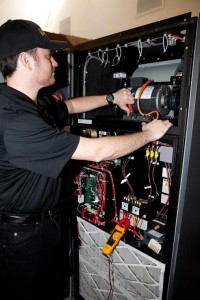
Evaluating Your Data Center Needs
As technology continues to play an increasingly-bigger role in business, data centers will continue to increase in size. Before you know it, your needs will be too big for that broom closet, much like a young Harry Potter outgrowing the cabinet under the stairs. So how will you adapt your office space to meet these new demands? And how will you continue to meet those demands?
Let Your Servers Breathe
Perhaps the biggest constraint most building owners and property managers face is space. Many data centers are packed wall-to-wall with equipment, which can cause several problems, including overheating. This brings us to our next point: data center cooling.
Data Center Cooling
Computer equipment, like servers, is highly sensitive to temperature fluctuations, humidity, air movement, and air quality. To address this, precision cooling systems are designed for precise climate control, year-long operation, and higher load densities. And such specialized cooling systems require specialized technicians.
Specialized experience and training are needed to properly design and service data centers and their cooling systems, which accounts for around 37-40% of total electricity use. There are several certifications required to become a factory authorized technician for many brands of cooling equipment, plus an advanced understanding of HVAC is needed.
System Redundancy
Response time is a big challenge, as most building owners or managers want to know they can have a technician on-site to fix a problem within two hours,” said Tom Zadera, business development manager, Crockett Facilities Services Inc., Bowie, Maryland. “Incorporating redundancy into a system is important, too, in case a unit goes down or needs to be repaired.”
Alternatives to Traditional Data Centers
Modular Data Centers
According to Zadera, modular data centers, a containerized solution that can quickly be deployed and installed in a parking lot, are quickly growing in popularity.
“Instead of dedicating thousands of square feet inside a facility, you can have a mobile container designed to your specifications and dropped off in the parking lot, where it takes up three to 10 parking spaces,” said Zadera. “That’s a very efficient way to expand, because you can standardize the design and then duplicate it as necessary as a company’s data storage needs grow.”
A Colocation: A Data Center in a Box
A colocation or colo – a data center in a box – is a prefabricated system (room or pod) placed into an existing building. These “boxes” include raised floors, all the electrical and HVAC, life safety, and so much more.
Compressorless Data Sites
More and more facilities are not using air conditioning. Instead, they are using free cooling along with computer equipment that can tolerate temperatures up to 95°F.
Data Center Cooling Services
At Crockett Facilities Services, Inc. (CFSI), our Emerson, Liebert and Stulz factory-trained service technicians understand the evolving complexities in managing heat loads and maintaining optimal temperatures. Our preventive maintenance programs are designed to protect your IT equipment investment and resolve critical cooling issues before they negatively impact your business.
We know that downtime is not an option!
To learn how our Crockett Facilities Services, Inc. can improve your data center performance, please contact CFSI by calling 202.600.2787 or email sales@crockett-facilities.com. CFSI provides 24/7 commercial mechanical and HVAC services throughout Washington D.C., Maryland, and Virginia. So give us a call today to find out how our MSCA GreenSTAR certified service technicians can improve your HVAC performance and energy efficiency.
You can also follow CFSI on Facebook, LinkedIn, Twitter, and Google+.
Sources:
